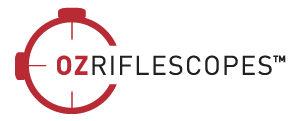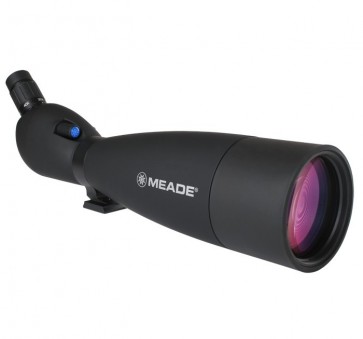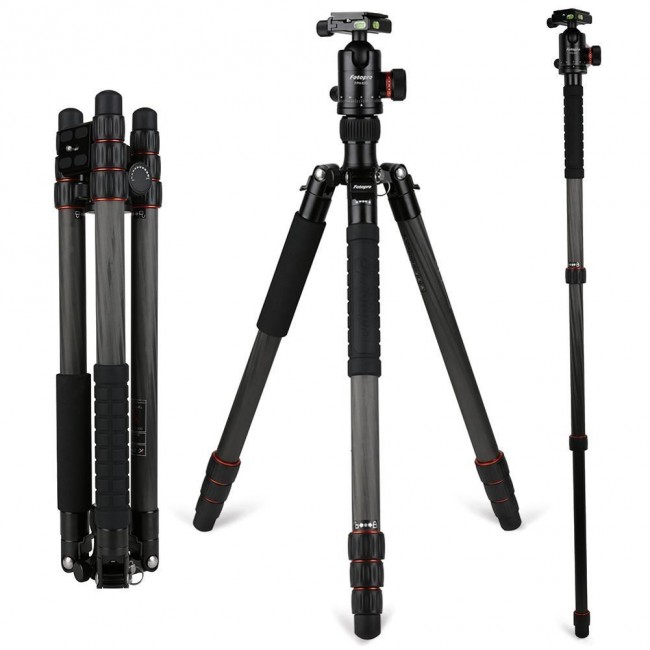CHAPTER 5: Spotting Scopes Review – A Buyers Guide
by: OZScopes – The Australia Telescope Experts
What are Spotting Scopes, anyway?
Spotting scopes are essentially compact telescopes designed and optimized for land (a.k.a. terrestrial) viewing. Spotting scopes are generally more powerful than binoculars, and binocular enthusiasts add a spotting scope to their collections when they need a scope with more power or magnification. Common uses for spotting scopes are to look at boats in the bay from your deck, being able to get better views of the panorama of your apartment, surveillance and hunting.
You might wonder why you're paying a bit more for spotting scopes than telescopes - but that's not quite the right question to be asking! Spotting scopes are considered a more powerful upgrade from binoculars, and have been designed with 2 key distinguishing features that differentiates them from astronomical telescopes:
a) A built in variable zoom eyepiece - variable zoom eyepieces allow you to zoom in and out on an image, much like you would with a camera. These eyepieces don't come standard with astronomy scopes, and typically cost about $200.
b) Multi-coat lenses - these coatings are for land-viewing. They boost "land colours", such as blues and greens, for a better viewing experience. If your spotting scope comes with what's called an "ED Coating", which stands for "Extra-Low Dispersion", this means that you've got an excellent scope. ED glass does away with what's called chromatic abberration - a distortion in the image when looking at very bright images, where lines are blurred with small spectrums of light. Astronomy scopes do not have coatings on their lenses - this is because they need to capture as much light as possible, and the coatings block out some light to protect your eyes during day-time viewing.
In addition, spotting scopes are more durable than astronomical telescopes. They've been designed to be portable, and hardy enough to be carried around when camping, hunting or on trips. This means that - unlike many astronomy telescopes - they don't require re-collimation or re-alignment after use or transport. In fact, spotting scopes require little to no user-related maintenance to keep them in tip-top shape, other than merely keeping the lens clean. They're also commonly waterproof and fog-proof, which adds to their rugged capability.
Most spotting scopes are refractor scopes - this means that the optics have been constructed with lenses instead of mirrors, and thus resemble what most people imagine traditional telescopes look like i.e. long cylinders, with the eyepiece at the bottom of the scope.
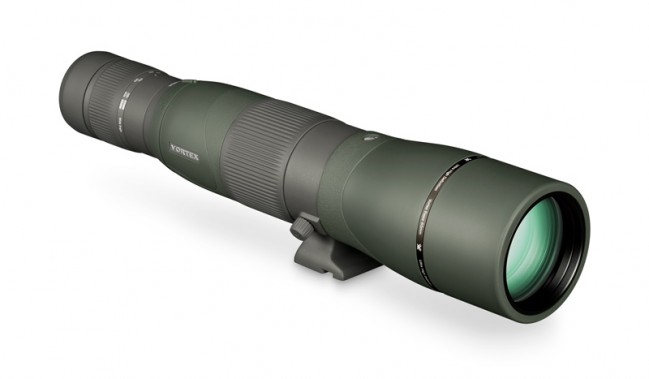
This an example of what a refractor style spotting scope looks like - this is a Celestron Ultima 100 22-66 x Straight Spotting Scope
Some spotting scopes are reflector-style scopes, which means that they use mirrors instead of lenses. They're generally more affordable than refractor style ones (mirrors are cheaper to make than lenses), but reflector style scopes are more compact and lighter as well. You'll also notice that they've been built in a distinctive "Z" shape, for light to bounce off the mirrors and through your eyepiece (see image below).
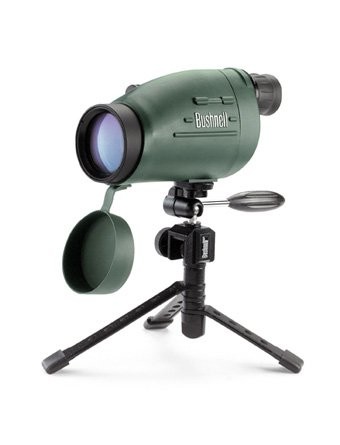
This an example of what a reflector style spotting scope looks like.
Generally, all spotting scopes have a common way of stating their specifications in their name. For example, with the Vortex Viper HD 20-60x85 Angled Spotting Scope (which is, incidentally, a really good spotting scope), you'll notice that there are some numbers in the title. Those are the specifications of the scope, and they are read like this:
a) Magnification/Power : the power or magnification of your spotting can be found in the first set of numbers in it specifications. In this case, it's a 20 - 60x variable magnification, so you can adjust the magnification of your scope to range anywhere between 20x and 60x.
b) Aperture : The aperture, or the size of the objective lens, can be found in the last set of numbers. Always read in mm, this pair has a 85mm aperture, which is nice and big for clear and accurate vision. Aperture merely refers to the diameter of the lens/mirrors, and the bigger the aperture the more light your scope is able to capture. This leads to heavier scopes, but images that are brighter, clearer, and more colour-precise.
If you're wondering which one's right for you - astronomy telescopes or spotting scopes - check out our guide here: Choosing Between Spotting Scopes And Telescopes. Read on below to find our more about spotting scopes!
Angled Spotting Scopes and Straight Spotting Scopes – What's the difference?
Spotting scopes come in two basic body designs - straight and angled (see above). In a Straight spotting scope, the eyepieces are aligned to each other so that the tube of the scope is completely straight, or linear. In an Angled spotting scope, the eyepiece is angled at 45 degree, or 90 degrees from the barrel. Ultimately, whether you go for a straight or angled spotting scope is up to personal preference, and perhaps what you would like to use the scope for. For example, if you wanted to mount your spotting scope to the glass window of a car for birdwatching (with a car window mount), you might be best to go with a straight design. That said, if you were fairly tall and wanted to use the scope to look out into the bay, an angled spotting scope might be more your thing. The design or angle of the scope does NOT affect the way the scope functions in any way – keep reading to find out more about straight and angled spotting scopes.
Check our our huge range of spotting scope.
Straight and Angled spotting scopes – basic differences in viewing
With a straight scope, your eyes are in a straight line with the object you're looking at. Angled spotting scopes, on the other hand, allow you to look down into the scope while observing, or – if you twist the eyepiece – will allow you to look from one side. An angled spotting scope will also allow you to do birdwatching at different heights by turning the scope to any side. With a straight scope you will have to adjust the height of the tripod according to how you're standing.
With a straight scope, you might have to bend your knees slightly to look through the scope (although you probably won't have to deal with the Fotopro X-GO Max Carbon Fiber Tripod with Monopod, which has a maximum height of 185cm).
With an angled scope, however, you'll have to turn your head slightly. An angled scope can be mounter lower for a better and steadier image formation. A straight scope should be mounted at eye height.
Depending on what you wanted to use the scope for , you'll have to consider things like weight, budget and capability.
A Note on Tripods
All spotting scopes have been manufactured to fit onto any standard tripod - you won't have to purchase any additional accessories to fit them on a tripod. You can definitely use a standard camera tripod if you so choose, but just be wary - most spotting scopes are heavier than the standard camera, and the tripod might not be able to take the weight of your new spotting scope. When you first put your spotting scope on a tripod, check to see that it's stable and that it doesn't tip - once it hits the floor it's sure to damage the internal optics of your scope!
In the event that you needed a new, heavy-duty tripod for your scope, you can consider either the Fotopro X-GO Max Carbon Fiber Tripod with Monopod which have purpose-built for heavy objects like spotting scopes.
Typically, spotting scopes don't come packaged with a tripod (unlike most astronomy scopes), and you will have to purchase them separately. That said, some spotting scopes - such as the Yukon Spotter 20-50x50 Spotting Scope below, come packaged with a table-top tripod. These tripods are much smaller, and are useful if you want to prop your scope up on a table, or when hunting.
How far will I be able to see with my spotting scope?
This is a common question we get asked - but it's not quite possible to answer it! It really is like asking - "How far can you see with your eyes?" It depends on how much clarity and visibility you want to be able to observe. A more accurate way of describing (and understanding) distance with spotting scopes are to consider what's called it's Field of View.
Field of View (FoV) refers to the width of the observable world you're able to see through your telescope. Your FoV changes whenever you change the power (or magnification) of your spotting scope's eyepiece.
For example, with the Acuter Nature Close 20-60x80 Angled Spotting Scope, you can find the FoV of this (any any of our) spotting scopes under the "Specifications" tab on its product page, which is just next to the "Product Description" tab. In the case of this Ultima 80, the linear FoV at 1000 yards (914m) is 105ft (32m) @ 20x magnification, and 53ft (16m) @ 60x magnification.
Will I be able to take pictures with my camera through my spotting scope?
In short? Yes.
I have a dSLR camera. How do I connect my camera to my spotting scope?
Keep an eye out to see if your telescope comes with what's called a "Built-in T-thread on Eyepiece". All the spotting scopes in the Celestron Ultima range of spotting scopes come with a built in T-thread on their eyepieces. This means that you will only need to puchase a T-Ring that's suited to your camera. They're manufactured according the the brand of your camera, and you can see our range of T-Rings here - we have them for Canon, Nikon, Sony and Pentax. If your spotting scope doesn't have a built-in T-thread - such as with any of Celestron's Cassegrain style spotting scopes - you will also have to purchase what's called a T-Adapter. This adapter fits into your telescope in lieu of an eyepiece (remove the eyepiece and slot in the T-Adapter instead). Your T-Adapter will then attach to the T-Ring which is on your camera. Voila! Your camera is now attached to your telescope! The one you need will be what's called a Celestron Universal 1.25 inch T-Adapter. If you've got a telescope with a 1.25 inch eyepiece, you're good to go with the Celestron Universal T-Adapter – 1.25”. This T-Adapter will fit most telescopes, especially if it is a reflector or refractor style telescope.
I have a standard digital (point and shoot) camera. How do I connect my camera to my spotting scope?
So if you own a standard point and shoot camera (e.g Cannon IXUS) there are still options for you to get some great astrophotography shots. Getting started requires just one tool (a lot simpler huh!) a Universal Digital Camera adapter. In terms of variety of choice you have 2 options, one being the Saxon Universal Digital Camera Adapter and the Celestron Universal Digital Camera Adapter. With the Celestron, you do pay a little bit more, but you get the associated brand-name, after sales service, and a slightly superior build.
These digital camera adapters perform the same function as a T-Ring – however, instead of screwing your camera onto the telescope, the digital camera adapter 'holds' your camera right up to the eyepiece of your telescope. Now, you might be thinking why you'd want to do that because you could do the same thing with your hands, but it is far more stable when you use an adapter than if you held it there on your own. You're probably already aware, but when you're taking pictures, stability is paramount for a clear, well-focussed image.
